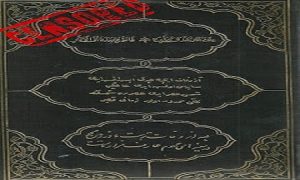Here’s a list of some censored books on the Baha’i Faith. These books were all suppressed by the Baha’i authorities, and in some cases, the authors were killed.
It would be great to see a more organised effort to distribute and translate these Persian works. Please feel free to add to the list, or share translations if you are aware of any.
- Nuqtatu’l-Kaf
- Nuqtatu’l-Kaf is a book that was originally published in 1851 but was suppressed in Iran. It contains material that is hostile to the Baha’i Faith. When E.G. Browne published the book with Persian and English introductions, a number of Baha’i scholars worked on refutations of the book, including Siyyid Mahdi Gulpaygani and Mirza Abu’l-Fadl. The book was discovered by E.G. Browne in Paris and published by him. This horrified Baha’i leaders who accused him of having become an Azali and of receiving a bribe from them to publish the book.
- The Philosophy of Niku (Filsifa-i-Niku)
- Even after he had given up the Baha’i faith, the Baha’is of Teheran continued to claim him as one of their own, and Niku was forced to write several volumes in Persian entitled “The Philosophy of Niku,” to prove that he had left the movement. In an able and interesting manner, Niku described the things which he had seen and heard which disillusioned him, such as the worldly ambition of Abdu’l-Baha, his greed for money, and his flattering epistles to great and wealthy people whom he hoped to win as disciples.
- Hash Bihisht (The Eight Paradises)
- The Hasht Bihisht is a book written by two sons-in-law of Subh-i-Azal, which contains the teachings and sayings of Haji Sayyid Jawad of Karbala, who was among the first Letters of the Living in the Bayan hierarchy. The book’s preface discusses the virtues and claims of the Bayan religion over all other religions, while the body of the work consists of eight chapters dealing with the practice of the Bayan religion and the events of the Day of Resurrection. The book also contains an Elucidation of the Direful Mischief, which refers to the secession between the Azalis and the Bahais, and ends with a narrative of a visit to Acre by one of the people of the Bayan, Mirza Aqa Khan of Kerman, who was also one of the co-authors of the book. The work is considered a systematic treatise in the philosophy, theory, ethics, morality, and history of the Bayan religion.
- Kitab-i-Subhi
- The Kitab-i-Subhi, written by Mirza Subhi, a former Persian scribe to Sir Abbas Effendi and a Bahai missionary. He wrote two books explaining why he left the Baha’i faith.
- Kashf-al-Hiyal (Exposure of Deception)
- The book Kashf-al-Hiyal was written by Abd-al-Husayn Avarih, who was a Bahá’í and had also written the Kavakibu’d-Durriyyih, an important history of the Bahá’í Faith. However, he later left the Bahá’í Faith and wrote the Kashf-al-Hiyal in three volumes. In the book, he related how he became a Bahá’í and why he defected. He also mentioned that while writing the history of the movement, Abdu’l-Baha forced him to misrepresent the facts. Avarih was a member of the Hands of the Cause and a prominent Bahá’í missionary who was greatly revered by the Bahá’ís. He served Shoghi Efendi for a number of years and was sent by him to Europe to make converts but later left the movement. In Kashf-al-Hiyal, Avarih confirmed the account of Hasht-Bihisht and added that the assassins of Baha’s brother Mirza Musa were Ustad Muhammad Ali the Barber and his accomplices.
- Book of Seraj
- Book of Qahir
- Tanbihun-Naimin
- The Tanbihun-Naimin, also known as The Awakening of the Sleepers, is a book comprising four parts. The first part is a facsimile of a letter from Abdul Baha to his aunt known as Khanum-i-Buzurg, urging her to believe in Baha and to renounce his half-brother Subh-i-Azal. The second part is a long reply from Khanum-i-Buzurg, commonly called Risala-i Amma, containing historical and biographical information about the Bahais, particularly during the Baghdad period and the schism between the Bahais and Azalis. The reply rebuts the claims of Baha’u’llah. The third part is a homily in Arabic followed by a refutation in Persian, both by Mirza Ahmad of Kerman. The fourth part is a facsimile of the Will and Testament of Baha, with the preamble and concluding notes in Baha’s handwriting and the body of the will in his secretary’s handwriting.
https://bahaism.blogspot.com/






